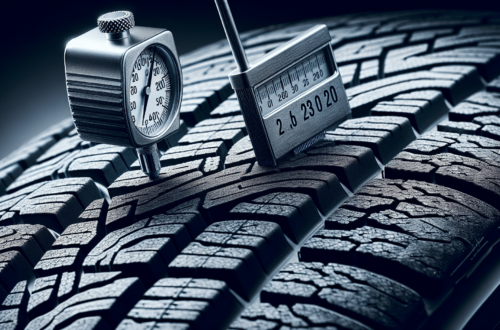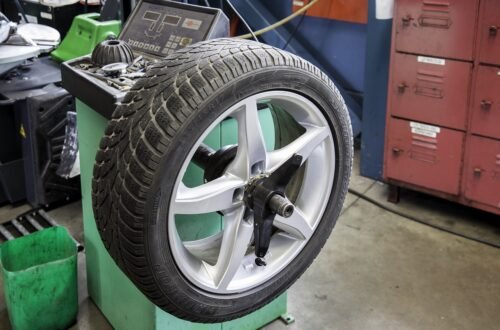Imagine this scenario: you’re cruising down the highway, enjoying the open road and the wind in your hair. But suddenly, the unexpected happens – your worn tires lose their grip on the wet pavement, causing your car to swerve out of control. In that split second, everything changes. This is the very reason why safe driving with worn tires is so crucial. It’s not just about the lifespan of your tires, but your own safety and the safety of others on the road. In this article, we will explore the importance of safe driving with worn tires and why it should never be taken lightly.
Understanding worn tires
Worn tires refer to tires that have been significantly used and have lost their original tread depth. Tread depth is the measurement of the space between the tire’s surface and the bottom of its grooves. Tires with worn tread have less ability to grip the road, making them less safe and less efficient. Understanding the causes of tire wear and the different types of tire wear is essential in maintaining road safety.
Causes of tire wear
Tire wear can be caused by various factors. One of the most common causes is improper tire inflation. Underinflated tires can cause greater friction between the tire and the road surface, resulting in excessive wear on the tire treads. Overinflating the tires, on the other hand, can cause the center of the tread to wear faster than the outer edges.
Another cause of tire wear is improper wheel alignment. When the wheels are not aligned properly, the tires may wear unevenly, with the inner or outer edges experiencing more wear than the rest of the tire. This can lead to reduced tire life and compromised vehicle performance.
Additionally, aggressive driving habits such as hard braking, rapid acceleration, and taking corners at high speeds can accelerate tire wear. Poor road conditions, such as potholes and debris, can also contribute to tire wear.

This image is property of images.pexels.com.
Different types of tire wear
There are several types of tire wear that drivers should be aware of.
- Uneven wear refers to wear patterns that are not consistent across the tire’s surface. This can be caused by improper tire inflation, misaligned wheels, or suspension issues.
- Cupping or scalloping is characterized by irregular, cup-shaped depressions on the tire’s surface. This type of wear is often caused by worn suspension components, unbalanced wheels, or shock absorber issues.
- Feathering occurs when the tread ribs have a rounded edge on one side and a sharp edge on the other. This can be caused by misaligned wheels or improper tire rotation.
- Center wear is when the center of the tire tread wears faster than the outer edges. This can be a result of overinflation or excessive braking.
- Shoulder wear is when the outer edges of the tire tread wear faster than the center. This can be caused by underinflation or aggressive cornering.
Understanding these types of tire wear can help drivers recognize potential issues and take the necessary steps to address them promptly.
The dangers of driving with worn tires
Driving with worn tires poses significant risks to both the driver and other road users. Here are some of the dangers associated with driving on worn tires.
Reduced traction and grip
One of the most critical dangers of driving on worn tires is the reduced traction and grip they provide. As the tire treads wear down, the tires lose their ability to grip the road surface effectively. This can result in decreased traction, especially on wet or slippery roads, making it more difficult for your vehicle to stop or turn safely.
Increased risk of hydroplaning
Worn tires are more prone to hydroplaning, which occurs when the tires lose contact with the road surface and glide on a layer of water. This can lead to a loss of control and make it extremely difficult to steer or brake effectively. Hydroplaning is particularly dangerous when driving at high speeds or during heavy rainstorms.
Longer braking distances
Worn tires require longer distances to come to a complete stop compared to tires with sufficient tread depth. As the tread wears down, the tire’s ability to grip the road and provide sufficient braking force diminishes. This means that your braking distances increase, making it more challenging to avoid collisions or respond to sudden stops.
Reduced maneuverability and control
Worn tires can compromise your vehicle’s maneuverability and control, especially in emergency situations. When tires lose their grip and ability to maintain traction, it becomes more difficult to navigate sharp turns or make quick lane changes. This can greatly increase the risk of accidents and make it harder to maintain control of your vehicle.
Higher risk of blowouts
Worn tires are more susceptible to blowouts, which occur when the tire sidewall fails and bursts. As tires wear down, the rubber becomes thinner, making it more vulnerable to punctures and structural damage. Blowouts can cause a sudden loss of control, resulting in a potentially severe accident.
It is vital to understand these dangers and take appropriate action to ensure your tires are in good condition before hitting the road.

This image is property of images.pexels.com.
Legal implications and penalties
Driving with worn tires can have legal consequences. Understanding the tire tread depth requirements, consequences for driving with worn tires, fines, and penalties, as well as the impact on insurance coverage, is essential to avoid legal troubles.
Tire tread depth requirements
In many jurisdictions, there are legal requirements for minimum tire tread depth. These requirements are in place to ensure a safe level of traction and prevent accidents caused by worn-out tires. The specific minimum tread depth varies by country, but it is typically around 1.6 millimeters. Drivers should regularly measure their tire tread depth to ensure compliance with local regulations.
Consequences for driving with worn tires
Driving with worn tires is considered negligent and can result in legal repercussions. If a driver is found to have knowingly operated a vehicle with tires that do not meet the minimum tread depth requirements, they may face fines, points on their license, and even license suspension or revocation. In some cases, repeat offenses can lead to more severe penalties.
Fines and penalties
The fines and penalties for driving with worn tires vary depending on the jurisdiction and the severity of the offense. In addition to fines, drivers may also face points on their license, which can lead to increased insurance premiums. It is important to be aware of the specific laws in your area and the potential consequences for non-compliance.
Impact on insurance coverage
Driving with worn tires can also have implications for insurance coverage. If a driver is involved in an accident and their tires are found to be worn or unsafe, their insurance company may deny their claim or reduce the amount of coverage provided. This can leave the driver responsible for the costs of repairing their vehicle and any damages caused to others.
Understanding the legal implications and potential penalties can serve as a motivation to prioritize tire maintenance and ensure compliance with local regulations.
Effects of worn tires on vehicle performance
The effects of worn tires go beyond just safety concerns. Worn tires can also have a negative impact on overall vehicle performance, including handling, fuel efficiency, road noise, and other vehicle components.
Negative impact on handling
Worn tires can significantly impact a vehicle’s handling and stability. When the tread depth decreases, the tire’s ability to maintain proper contact with the road surface diminishes. This can lead to decreased responsiveness, imprecise steering, and a less comfortable driving experience. It is important to have adequate tire tread to ensure optimal handling and control.
Reduced fuel efficiency
Worn tires can also contribute to reduced fuel efficiency. As tires wear down, the rolling resistance increases, requiring the engine to work harder and consume more fuel to maintain the same speed. This can result in decreased gas mileage and increased fuel costs. By maintaining proper tire tread depth, drivers can help improve their vehicle’s fuel efficiency and save money at the pump.
Increased road noise and vibrations
Worn tires tend to produce more road noise and vibrations compared to tires with sufficient tread depth. As the tire tread wears down, the contact between the tire and the road surface becomes less smooth, resulting in increased noise and vibrations. This not only diminishes the driving experience but can also be an indication of other underlying tire or suspension issues. Regular tire maintenance can help minimize these disruptions and ensure a quieter ride.
Accelerated wear on other vehicle components
Worn tires can also cause accelerated wear on other vehicle components. When the tires lack adequate tread depth, they have less shock absorption capacity, putting additional strain on the suspension system, wheel bearings, and other components. This can lead to premature wear and increase maintenance costs. By replacing worn tires promptly, drivers can help protect their vehicle’s overall performance and longevity.
Understanding the effects of worn tires on vehicle performance emphasizes the need for regular tire maintenance and prompt replacement when necessary.

This image is property of images.pexels.com.
Ways to check tire wear
Regularly checking for tire wear is crucial in maintaining optimal road safety. There are several methods to assess tire wear and determine whether replacement is necessary.
Tire tread depth gauge
Using a tire tread depth gauge is the most accurate way to measure the depth of the tire treads. These gauges are inexpensive and readily available at automotive supply stores. By inserting the gauge probe into the tire groove, drivers can measure the remaining tread depth and determine if it meets the legal requirements or needs replacement.
Tire wear indicator bars
Most modern tires are equipped with tire wear indicator bars, also known as wear bars. These bars are small, raised sections located between the tread grooves. As the tire treads wear down, these bars become more visible. When the wear bars are level with the tread surface, it is a clear sign that the tires are worn and need to be replaced.
Visual inspection for uneven wear patterns
Regular visual inspections can provide valuable insights into tire wear patterns. Uneven wear is a common indicator of alignment, suspension, or inflation issues. By examining the tire treads carefully, drivers can identify signs such as cupping, feathering, or shoulder wear. If any irregular wear patterns are detected, it is important to address the underlying issue and replace the tires accordingly.
By utilizing these methods of checking tire wear, drivers can proactively monitor the condition of their tires and ensure they are safe for the road.
When to replace worn tires
Knowing when to replace worn tires is crucial in maintaining road safety and vehicle performance. In addition to legal requirements, there are several signs and indicators to look out for.
Minimum legal tread depth requirements
As previously mentioned, there are legal requirements for minimum tire tread depth in many jurisdictions. It is important to familiarize yourself with the specific requirements in your area and monitor your tire tread regularly to ensure compliance. Once the tread depth reaches or falls below the legal minimum, it is time to replace the tires.
Signs of excessive wear
Aside from legal requirements, there are visual cues that indicate excessive tire wear. These signs can include noticeable tread wear bars, uneven wear patterns, exposed cords or wires, or any damage to the tire sidewalls. If any of these signs are present, it is crucial to replace the tires promptly.
Warning signs of imminent tire failure
Certain warning signs can indicate imminent tire failure, and immediate replacement is necessary. These include bulges or bubbles on the tire sidewalls, severe sidewall or tread damage, or frequent tire blowouts. These warning signs pose serious safety risks, and driving on tires exhibiting these signs should be avoided at all costs.
By paying attention to these indicators, drivers can make informed decisions about replacing worn tires, ensuring their safety and the safety of others on the road.
Importance of regular tire maintenance
To maximize tire lifespan and ensure optimal safety and performance, regular tire maintenance is essential. Here are some key aspects of tire maintenance that every driver should prioritize.
Rotating tires for even wear
Rotating tires involves switching their positions on the vehicle at regular intervals. This helps promote even wear across all tires, as each tire experiences different forces depending on its location. By following the manufacturer’s recommended rotation pattern, drivers can extend tire life and maintain optimal performance.
Proper tire inflation
Maintaining proper tire inflation is crucial for optimal safety and performance. Underinflated tires can lead to increased tire wear, decreased fuel efficiency, and compromised handling. Conversely, overinflated tires can result in uneven wear and reduced traction. Drivers should regularly check and maintain proper tire pressure according to the manufacturer’s recommendations.
Alignment and balancing
Regular wheel alignment and balancing are important for maintaining even tire wear and optimal vehicle handling. Proper alignment ensures that the wheels are angled correctly, minimizing tire wear and maximizing fuel efficiency. Wheel balancing ensures even weight distribution and prevents vibrations that can lead to premature tire wear.
Regular tire rotation and inspection
In addition to rotating tires for even wear, regular tire rotation involves thorough inspections to identify any signs of wear, damage, or potential issues. This allows drivers to address any concerns promptly and avoid more significant problems down the road. Regular tire inspections should be part of every driver’s routine maintenance schedule.
By prioritizing regular tire maintenance, including rotation, inflation, alignment, balancing, and inspection, drivers can prolong tire life, enhance vehicle performance, and ensure optimal safety on the road.
Investing in quality tires
Choosing the right tires for your vehicle is crucial for performance, safety, and overall satisfaction. Here are some factors to consider when investing in quality tires.
Choosing the right tire type for your vehicle
Different vehicles have different tire requirements based on their size, weight, and intended use. It is important to choose tires that are compatible with your vehicle’s specifications. Whether you need all-season tires for everyday driving, winter tires for snowy conditions, or performance tires for enhanced handling, selecting the right tire type is essential for optimal safety and performance.
Tire quality vs. price
When it comes to tires, quality should be prioritized over price. While budget tires may seem cost-effective, they often compromise on performance, safety, and longevity. Investing in high-quality tires from reputable brands may initially cost more, but they offer better traction, improved handling, longer tread life, and overall better value in the long run.
Benefits of premium tires
Premium tires offer several advantages over their economy counterparts. They are designed with advanced technologies and materials to provide enhanced grip, improved handling, and reduced braking distances. Premium tires also tend to have lower rolling resistance, contributing to better fuel efficiency. Additionally, they are often quieter and more comfortable compared to budget options.
Considering seasonal tires
In regions with distinct seasons, it is beneficial to consider using seasonal tires. Winter tires, specifically designed for cold weather and snowy conditions, offer superior traction and handling compared to all-season tires. By switching to winter tires during the colder months, drivers can significantly improve their safety and performance on snow-covered or icy roads.
By investing in quality tires that are suitable for your vehicle and driving conditions, you can ensure optimal safety, performance, and satisfaction on the road.
Safe driving practices
While maintaining safe tires is crucial, safe driving practices also play a vital role in overall road safety. Here are some key practices to follow when driving, especially with worn tires.
Maintaining a safe following distance
Keeping a safe following distance is essential to ensure adequate time to react and stop in case of emergencies. With worn tires, the braking distances may be longer, making it even more important to maintain a sufficient distance behind the vehicle ahead.
Adjusting driving behavior in adverse conditions
Adverse weather conditions, such as rain, snow, or ice, can make driving with worn tires even more challenging. It is crucial to adjust driving behavior by reducing speed, avoiding sudden maneuvers, and maintaining a safe distance from other vehicles. Driving cautiously and allowing extra time for braking and turning can help mitigate the risks associated with worn tires in adverse conditions.
Avoiding sudden acceleration or braking
Abrupt acceleration or braking can put additional stress on worn tires, increasing the risk of skidding or loss of control. Drivers should aim for smooth and gradual acceleration and braking to minimize the strain on the tires and maintain better traction with the road surface.
Being mindful of tire pressure
Regularly monitoring tire pressure is important for safe driving, especially with worn tires. Properly inflated tires provide better traction, handling, and control. It is essential to check tire pressure at least once a month and adjust it according to the manufacturer’s recommendations.
By practicing safe driving habits and being mindful of the limitations of worn tires, drivers can further enhance road safety and mitigate potential risks.
Conclusion
Prioritizing tire safety is paramount to ensuring overall road safety. Understanding the dangers of driving with worn tires, the legal implications and penalties, the effects on vehicle performance, and the importance of regular maintenance empowers drivers to take responsibility and make informed decisions.
By regularly checking tire wear, replacing worn tires promptly, investing in quality tires, practicing safe driving habits, and maintaining regular tire maintenance, drivers can significantly reduce the risks associated with worn tires and contribute to safer roadways.
Taking responsibility as a driver means acknowledging the consequences of neglecting tire maintenance and making the necessary efforts to prioritize tire safety. By doing so, drivers can protect themselves, their passengers, and other road users, ultimately creating a safer and more enjoyable driving experience for all.





